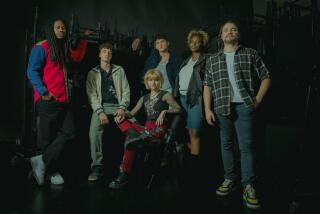Moviegoing Devices for the Disabled Make Their Debut
- Share via
When Academy Award-winning actress Marlee Matlin goes to a movie premiere, she has to rely on a sign-language interpreter to convey the dialogue.
When Mitch Pomerantz, past president of the California Council of the Blind, asked a friend to describe a movie’s on-screen action, nearby viewers weren’t too pleased.
But the moviegoing experience for Americans with vision or hearing disabilities may soon change dramatically, thanks to two new technologies that debuted last week at the General Cinema Theatre in Sherman Oaks.
The Rear Window Captioning System provides subtitles--via a seat-mounted acrylic panel--that appear to be superimposed on the movie screen. The Descriptive Video Service Theatrical system offers descriptive narration of on-screen action via wireless headsets.
Both technologies were developed by the WGBH Educational Foundation in Boston with a grant from the Department of Education. They’ll be available on a trial basis through Tuesday at the Sherman Oaks theater during regularly scheduled screenings of Universal Pictures’ “The Jackal.”
“I believe we’re making history here,” said William J. Smith, the theater’s general manager. Movie theaters have been under pressure to accommodate people with disabilities, and the new technologies have the potential to provide an effective, relatively low-cost solution.
The Rear Window system uses a light-emitting diode display mounted on the rear wall of the theater. Words are reflected on the acrylic panels, which are attached to an adjustable wire stand that fits into the cup holder at each seat. The panel unit is portable, enabling the user to sit almost anywhere in the theater.
For the vision-impaired, the DVS Theatrical system provides description of actions, settings and scene changes, using infrared or FM listening devices.
Both systems operate in unison, using a CD-ROM player and a special reader attached to the film projector that keeps the caption and audio information in sync.
The hardware costs about $15,000 for each theater, and Smith said there were no serious technical glitches with the trial installation.
A key goal of the trial was to get feedback from deaf and blind moviegoers, project manager Judith Navoy said. Members of the Greater Los Angeles Council on Deafness and the California Council of the Blind were invited to try the new systems and complete a questionnaire.
While written results have yet to be analyzed, the anecdotal comments have been favorable.
Blind patron Mitch Pomerantz, an American With Disabilities Act compliance officer for the city of Los Angeles, tried the DVS Theatrical system Wednesday night.
“It was a great experience,” he said. “I have used descriptive video before, but not in a regular public theater.” Pomerantz was accompanied by his friend and professional associate, Richard Ray, who is deaf. Ray tried out the Rear Window system, calling it “excellent, a brilliant idea.”
But such technology isn’t favored by all activists. Many have been pressing for all films to have subtitles visible without special equipment--a solution opposed by the movie industry as intrusive for other patrons.
Representatives from Sony, DreamWorks, Warner and Fox came to the theater and sampled both systems, and Navoy said the response was “overwhelmingly positive.”
It remains unclear how quickly the systems might be adopted. Movie studios have to agree to create the narratives for the DVS systems at an estimated cost of $12,000 per film. And, of course, theater owners have to install the gear.
The subtitling system will work better in some theaters than in others, because it requires a direct line of sight from the rear screen to the seat-mounted panels.
With an estimated 24 million Americans living with deafness or hearing loss, proponents hope that the industry will consider it in its economic interest to move quickly.
More to Read
The biggest entertainment stories
Get our big stories about Hollywood, film, television, music, arts, culture and more right in your inbox as soon as they publish.
You may occasionally receive promotional content from the Los Angeles Times.










